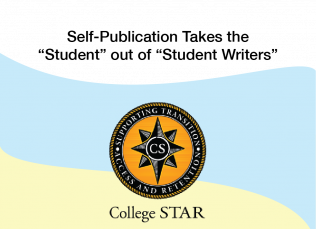
Self-Publication Takes the “Student” out of “Student Writers”
This case study describes a collective self-publication project facilitated with college students in a freshman English class. Through a series of rigorously structured steps, the students composed and revised original pieces of personal narrative writing using the KDP Platform on Amazon.
This resource was originally developed with resources from the College STAR grant. That grant has ended and the College STAR modules will now permanently reside at the East Carolina University Office for Faculty Excellence.
Module Introduction
This case study describes a collective self-publication project I facilitated with college students in a freshman English class. Through a series of rigorously structured steps, the students composed and revised original pieces of personal narrative writing, arranged their pieces into individual chapters, combined their chapters into a multi-author manuscript, and published the resulting book, which we called Writing Our Truth: Stories of Struggle and Survival, using the KDP platform on Amazon. Along the way, students not only received a crash course in writing for publication, but they also developed online marketing materials to promote the book; made decisions about the book’s layout, format, design, and editing; and collaborated to coordinate a book launch party and to schedule other promotional events. Most importantly, they came to identify themselves as professional, published authors, which, in fact, they were. As part of their experience as professional writers, the students have not only seen their own book get published, circulated, reviewed, and sold, but they have also been interviewed by a film crew about their writing, they have discussed their craft with other professional writers, and they have been planning their own marketing strategy. In public appearances and media interviews about their writing, as well as in our in-class discussions, they came to talk about their writing as a vocation and a craft. This experience provided a dramatic lesson in the ability of self-publication to increase the relevance of writing assignments, to foster a sense of community, and to empower students to own their voice and to write their truth.
The case study will describe the process we used to complete this enormous project in the span of a single semester. We started off with a clearly articulated schedule of deadlines that would ensure that we would have enough time to compile the content for the book, to arrange and edit it thoughtfully, and to oversee the publication rollout. We organized the semester into a writing phase, a design/editing phase, and a marketing phase. Our last class was the book launch party. Over the course of the semester, the classroom activities varied widely according to the phase of the project, beginning with “open mic” style readings in which the students shared their memoir essays with one another, then evolving into workshop and peer-review sessions, and finally transforming into a series of editorial “board” meetings, where we all sat around a big table and brainstormed ideas about what the book should look like and how we should let people know about it. Although the particular class of students who worked on this project was somewhat unique (they were all in a cohort model together, and they all shared an enthusiasm for writing), this book-writing project is entirely replicable in other contexts, with the right preparation. The case study will also consider ways in which this project can be modified for different disciplines, and it also provides important suggestions for avoiding some of the pitfalls and complications that we encountered.
Support for this Module
Original development of this module was made possible by the College STAR (Supporting Transition Access and Retention) initiative. College STAR was a grant-funded project focused on partnering postsecondary educational professionals and students to learn ways for helping postsecondary campuses become more welcoming of students with learning and attention differences. Much of this work was made possible by generous funding from the Oak Foundation.
Organization/Publishers:
Share this resource:
Posted date:
November 11, 2022
